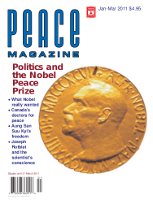
Peace Magazine Jan-Mar 2011, page 29. Some rights reserved.
Search for other articles by Penny Sanger here
By Jane Drake and Ann Love. Tundra Books, 2010
YES YOU CAN! is a small book packed with great stories and detailed advice, encouragement and warnings for anyone who plans to change the world, intended for—but not restricted to—young people. Here are the examples: Amnesty International, blue box recycling, Greenpeace, how to start an arts and heritage festival in remote northern Canada, Save the Children, the American civil rights movement, non-smokers’ rights, Pollution Probe, and others. The point is that it can be done by one or two enthusiasts. Reading how each of these started and is now part of most activists’ landscape makes gripping learning—and it’s all packed into fewer than 150 pages.
Outrage is the best beginning. Are you seriously fed up with an issue and “no one is doing anything about it”? The Toronto based sisters Jane Drake and Ann Love make the point that outrage is a good basis for action, especially if you find allies. They list nine steps: first define the problem by writing it out until it makes sense. Next find supporters (even one will do at first), then go public by writing a snappy press release, raise some money, and finally and hopefully, when your dream is reality and the excitement has faded—just keep going!
Most of the examples are Canadian and all are do-able, though luck is not excluded. In Labrador life wasn’t great for many teenagers until teacher Tim Borlase came along and offered another option to their staple recreation of huntin’, fishin’, and shootin’. Now, each November the Labrador Creative Arts Festival features plays, dancing and drumming, storytelling and mime produced and written by students who are learning to value their Métis, Innu and Inuit traditions and heritage—as well as the chance to use drama to expose current injustices and concerns.
In the US during the 1950s fifty percent of men and thirty-three percent of women smoked. Smoking was glamorized in Hollywood movies and different brands were advertised on television and everywhere else including huge highway billboards. But forty years later there was huge change. Only twenty-five percent of Americans continued to smoke. Health campaigners exposed the tobacco companies’ cheating and lies. Medical research showed the link between smoking and cancer and very soon Canadian researchers found nicotine in the lungs of babies who had died from Sudden Infant Death Syndrome (SIDS). In 1974 Toronto nurse Rosalee Berlin had founded NSRA (Non-smokers’ Rights Association) by crusading for clear air in the workplace—resulting in the now familiar sight of office employees puffing and huddling together outside in the cold. President Obama, trying to quit smoking, has promised to observe the ban on it while in the White House.
These are just two of the stories the sisters Jane and Ann have researched and presented in their guide to being an activist. To start though they suggest a bit of introspection, such as creating your own ideal self-portrait by choosing from lists of 24 ideal behaviours and the same number of those you despise, and considering how they apply in your own everyday life and then to the cause who are hoping to take on. To my mind, this is overdoing it. Any person who reads this book seriously and still passionate to pursue her cause will JUST DO IT!
Reviewed by Penny Sanger, a peace educator in Ottawa.

Peace Magazine Jan-Mar 2011, page 29. Some rights reserved.
Search for other articles by Penny Sanger here